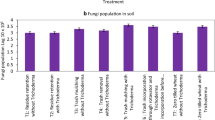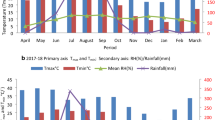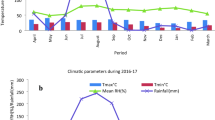Abstract
Intensive cropping and exhaustive nature sugarcane crop in tropical India have led to depletion of inherent soil fertility resulting in serious threat to sustainable sugarcane production. Improving soil organic matter and soil fertility are important factors for sustainable sugarcane production. Microbial consortia comprising of Trichoderma viride, Humicola spp, Paecilomyces lilacinus, Gluconacetobater diazotropicus, Azospiriillum brasilense, and Bacillus subtilis have great potential to recycle crop residue and restore soil fertility which eventually promote sugarcane growth. Field experiments with in situ trash management in plant crop and bio-intensive modulation of sugarcane ratoon rhizosphere in ratoon crops were conducted during 2014, 2015 and 2016 at ICAR—Sugarcane Breeding Institute, Coimbatore, Tamil Nadu, India. The results revealed that green manuring with sunnhemp, in situ trash management and application of 280:62.5:120 kg NPK ha−1 in plant crop sustained the soil health by way of reducing soil bulk density (1.26 kg dm−3), lower soil penetration resistance in the ratoon rhizosphere (1.79, 1.82 and 1.75 MPa) and higher soil organic carbon (0.52%) which in turn increased ratoon cane yield 12.24% (99.02 t ha−1) and sugar yield by 8.64% (12.83 t ha−1) over the control. Further, bio-intensive modulation of ratoon rhizosphere by off barring, trash shredding plus soil incorporation with microbial consortia and application of 350:62.5:120 kg NPK ha−1 in ratoon crop recorded significantly higher cane yield (100.95 t ha−1) and sugar yield (13.19 t ha−1) over the control. The improvement in cane yield and sugar yield to the tune of 16.35 and 14.10% due to bio-intensive modulation of ratoon rhizosphere over control have clearly established that productivity of sugarcane ratoon can be significantly improved with balanced use of fertilizers, green manuring, crop residue recycling and microbial consortia application. Similarly, bio-intensive modulation of sugarcane ratoon rhizosphere (S3) with lowest soil bulk density (1.26 kg dm−3) and soil penetration resistance values (1.69, 1.81, and 1.75 MPa) was found effective in minimising the soil compaction and improving nutrient availability (NPK) with build-up of soil microbial population than control (Trash removal). Based on the results of 3-year field experiments, it is concluded that sunnhemp green manuring and in situ sugarcane trash management coupled with application of 280:62.5:120 kg NPK ha−1 in plant crop followed by bio-intensive modulation of ratoon rhizosphere including off barring, trash shredding and soil incorporation with microbial consortia and application of 350:62.5:120 kg NPK ha−1 in ratoon crop can be recommended for sustaining soil health and sugarcane productivity under wide-row sugarcane planting systems of tropical Indian condition.



Similar content being viewed by others
References
Abu-Hamdeh, N.H. 2003. Soil compaction and root distribution for okra as affected by tillage and vehicle parameters. Soil Tillage Research 74: 25–35.
Alameda, D., N.P.R. Anten, and R. Villar. 2012. Soil compaction effects on growth and root traits of tobacco depend on light, water regime and mechanical stress. Soil Tillage Research 120: 121–129.
Bhowmik, S.N., and B.K. Konde. 1997. Isolation of efficient dinitrogen fixing Acetobacter from indigenous sugarcane genotypes. Journal of Maharashtra Agricultural Universities 22: 364–365.
Canarache, A. 1990. PENETR-A generalized semi-empirical model estimating soil resistance to penetration. Soil and Tillage Research 16: 51–70.
Cong, P.T., and R. Merckx. 2005. Improving phosphorous availability in two upland soils of Vietnam using Tihonia diversifolia. Plant and Soil 269: 11–23.
De Deyn, G., C. Raaijmakers, and W. Van der Putten. 2004. Plant community development is affected by nutrients and soil biota. Journal of Ecology 92: 824–834.
Dhanapal, R., A.S. Tayade, A. Bhaskaran, and P. Geetha. 2018. Efficient water management in sugarcane with composted coir pith and sugarcane trash under tropical Indian conditions. Sugar Tech. https://doi.org/10.1007/s12355-018-0593-3.
Ekwue, E.I., and R.J. Stone. 1995. Organic matter effects on the strength properties of compacted agricultural soils. Transactions of ASAE 38: 357–365.
Fuentes-Ramirez, L.E., T. Jimnez Salgado, I.R. Abarca-Ocampo, and J. Caballero-Mellado. 1993. A.diazotrophicus, an indole acetic acid producing bacterium isolation from sugarcane cultivars of Mexico. Plant and Soil 154: 145–150.
Gomez, K.A., and A.A. Gomez. 1984. Statistical procedures for agricultural research. Singapore: Wiley.
Gorucu, S., A. Khalilian, Y.J. Han, R.B. Dodd, and B.R. Smith. 2006. A algorithm to determine the optimum tillage from soil penetrometer data in coastal plain soils. Applied Engineering in Agriculture 22: 625–631.
Graham, M.H., R.J. Haynes, and J.H. Mayer. 2002. Changes in soil chemistry and aggregate stability induced by fertilizer applications burning and trash retention on a long term sugarcane experiment in South Africa. European Journal of Soil Science 53: 589–598.
Jackson, M.L. 1973. Soil chemical analysis. New Delhi: Prentice-Hall of India Pvt. Ltd.
Jadhav, M.B., S.M. Jagtap, R.V. Kulkarni, and A.B. Marathe. 2005. Studies on in situ trash management and fertilizer application techniques in multiple ratooning of sugarcane. Journal of Soils and Crop 15(2): 297–303.
Jones, D.L., C. Nguyen, and R.D. Finlay. 2009. Carbon flow in the rhizosphere: Carbon trading at the soil-root interface. Plant and Soil 321: 5–33.
Kingwell, R., and A. Fuchsbichler. 2011. The whole-farm benefits of controlled traffic farming: An Australian appraisal. Agricultural System 104: 513–521.
Lau, J.A., and J.T. Lennon. 2011. Evolutionary ecology of plant-microbe interactions: Soil microbial structure alters selection on plant traits. New Phytologist 192: 215–224.
Materechera, S.A. 2009. Tillage and tractor traffic effects on soil compaction in horticultural fields used for peri-urban agriculture in semi arid environment of the North West Province, South Africa. Soil and Tillage Research 103: 11–15.
Mowade, S., and P. Bhattacharyya. 2000. Resistance of P solubilizing Acetobacter diazotrophicus to antibiotics. Current Science 79: 1591–1594.
Meade, G.P., and J.C.P. Chen. 1977. Cane sugar handbook. 10th ed, 515–545. New York: Wiley.
Oliveira Filho, F.X., N.O. Miranda, J.F. Medeirors, P.C.M. Silva, F.O. Mesquita, and T.K.G. Costa. 2015. Zona de manejo para prepare do solo na cultura da cana-de-acucar. Rev Bras de Eng Agr e Amb 19: 186–193.
Otto, R., A.P. Silva, H.C.J. Franco, E.C.A. Oliveira, and P.C.O. Trivelin. 2011. High soil penetration resistance reduces sugarcane root system development. Soil and Tillage Research 117: 201–210.
Qing, L., Wei P.O. Gang, Chen Gui-Fen, L. Bin, Huang Dong Liang, and R.L. Yang. 2014. Effect of trash addition to the soil on microbial communities and physio-chemical properties of soils and growth of sugarcane plants. Sugar Tech 16: 400–404.
Schnitzer, S.A., J.N. Klironomos, J. Hillerislambers, L.L. Kinkel, P.B. Reich, K. Xiao, M.C. Rillig, B.A. Sikes, R.M. Callaaway, S.A. Mangan, E.H. Van Nes, and M. Schelffer. 2011. Soil microbes drive the classic plant diversity-productivity pattern. Ecology 92: 296–303.
Shukla, S.K., R.L. Yadav, A. Suman, and P.N. Singh. 2008. Improving rhizosphere environment and sugarcane ratoon yield through bio-agent amended farm yard manures in udic Ustochrept soil. Soil and Tillage Research 99: 158–168. https://doi.org/10.1016/j.still.2008.02.007.
Souza, H.A., A.V. Marcelo, and J.F. Centurian. 2012. Carbono organico e agregacao de um Latossolo Vermelho com colheita mecanizada de cana-de-acucar. Rev.Ci.Agr. 43: 658–663.
Souza, G.S., Z.M. Souza, R.B. Silva, R.S. Barbosa, and F.S. Araujo. 2014. Effect of traffic control on the soil physical quality and the cultivation of sugarcane. Rev Br.Ci do Sol 38: 135–146.
Swinford, J.M., and M.C. Swinford. 1984. The effect of soil compaction due to infield transport on ratoon cane yields and soil physical characteristics. Proc. S.Afr Sug Technol Ass 58: 198–203.
Tayade, A.S., P. Geetha, R. Dhanapal, and K. Hari. 2016. Effect of in situ trash management on sugarcane under wide row planting system. Journal of Sugarcane Research 6(1): 35–41.
Thakur, S.K., C.K. Jha, Geeta Kumari, and V.P. Singh. 2010. Effect of Trichoderma inoculated trash, nitrogen level and biofertilizers on performance of sugarcane (Saccharum officinarum) in calcareous soils of Bihar. Indian Journal of Agronomy 55(1): 308–311.
Tilak, K.V.B.R., A.K. Saxena, and N. Dutta. 1999. Soil microflora: Response to soil-crop management. In Management of tropical agroecosystems and the beneficial soil bioata, ed. M.V. Reddy, 137–151. New Delhi: Oxford and IBH Publishing Co. Pvt. Ltd.
Torres, J.R.L., M.G. Pereira, R.L. Assis, and Z.M. Souza. 2015. Atribtos fisicos de um Latossolo Vermelho cultivado com plantas de cobertura, em semeadura direta. Rev Br de Ci do sol 39: 428–437.
Van Antwerpen, R., and J.H. Mayer. 1997. Soil degradation -1: Effect of fertilizer use on penetrometer resistance. Proc S. Afr. Sug. Technol Ass 71: 18–21.
Van der Heijden, M.G.A., R.D. Bardgett, and N.M. Van Straalen. 2008. The unseen majority: Soil microbes as drivers of plant diversity and productivity in terrestrial ecosystem. Ecology Letters 11: 296–310.
Vepraskas, M.J., and G.S. Miner. 1986. Effects of sub-soiling and mechanical impendence on tobacco root growth. Soil Science Society of America, Proceedings 50: 423–427.
Wollum, A.G. 1982. Cultural methods for soil microorganisms. In Methods of soil analysis. Part 2. Chemical and microbiological properties, eds. A.L. Page, R.H. Miller, D.R. Keeney, Agronomy monograph No. 9. Madison (WI): ASA and SSSA, 781–814.
Yadav, R.L., S.K. Shukla, A. Suman, and P.N. Singh. 2009. Trichoderma inoculation and trash management effects on soil microbial bio-mass, soil respiration, nutrient uptake and yield of ratoon sugarcane under subtropical conditions. Biology and Fertility of Soils 45: 461–468.
Author information
Authors and Affiliations
Corresponding author
Ethics declarations
Conflict of interest
We, the authors, declare that we have no conflict of interest.
Rights and permissions
About this article
Cite this article
Tayade, A.S., Geetha, P., Anusha, S. et al. Bio-intensive Modulation of Sugarcane Ratoon Rhizosphere for Enhanced Soil Health and Sugarcane Productivity Under Tropical Indian Condition. Sugar Tech 21, 278–288 (2019). https://doi.org/10.1007/s12355-018-0669-0
Received:
Accepted:
Published:
Issue Date:
DOI: https://doi.org/10.1007/s12355-018-0669-0




